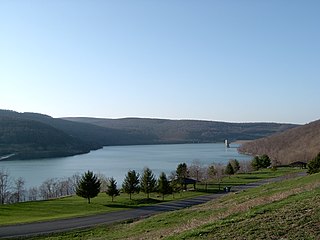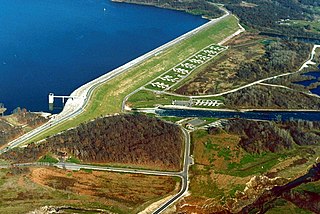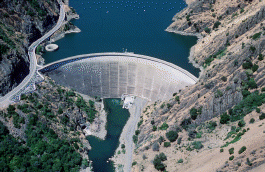This article relies largely or entirely on a single source .(December 2018) |
| Curwensville Dam | |
|---|---|
| Official name | Curwensville Dam |
| Location | Pike Township, near Curwensville, Pennsylvania |
| Coordinates | 40°57′14″N78°31′34″W / 40.954°N 78.526°W Coordinates: 40°57′14″N78°31′34″W / 40.954°N 78.526°W |
| Dam and spillways | |
| Impounds | West Branch Susquehanna River |
| Length | 2,850 feet (1,050 m) |
| Reservoir | |
| Creates | West Branch Susquehanna River |
Curwensville Dam is located on the West Branch Susquehanna River about 0.6 miles (1 km) upstream from Curwensville in Clearfield County, Pennsylvania. The dam is an earth fill structure 2,850 feet long, rising 131 feet above the stream bed, with a spillway and gate-controlled outlet.

The West Branch Susquehanna River is one of the two principal branches, along with the North Branch, of the Susquehanna River in the northeastern United States. The North Branch, which rises in upstate New York, is generally regarded as the extension of the main branch, with the shorter West Branch being its principal tributary. The West Branch, which is 243 miles (391 km) long, is entirely within the state of Pennsylvania, draining a large mountainous area within the Allegheny Plateau in the western part of the state. Along most of its course it meanders along mountain ridges and through water gaps, forming a large zigzag arc through central Pennsylvania around the north end of the Allegheny Ridge. In colonial times the river provided an important water route to the Ohio River valley. In the 18th century, its lower valley became a significant industrial heartland of Pennsylvania. In the 20th century, the upper reaches of the West Branch turned a yellow/orange color due to sulfurous drainage from nearby and abandoned deep bituminous coal mines.

Clearfield County is a sixth-class county located in the U.S. state of Pennsylvania. As of the 2010 census, the population was 81,642. The county seat is Clearfield, and the largest city is DuBois. The county was created in 1804 and later organized in 1822.

A spillway is a structure used to provide the controlled release of flows from a dam or levee into a downstream area, typically the riverbed of the dammed river itself. In the United Kingdom, they may be known as overflow channels. Spillways ensure that the water does not overflow and damage or destroy the dam.
The reservoir, Curwensville Lake, has a storage capacity of 124,200 acre foot (153,000,000 m3) at spillway crest and extends 14 miles (23 km) upstream when filled to that level. The project controls a drainage area of 365 square miles (950 km2) or 98 percent of the West Branch at Curwensville and 75 percent at Clearfield, PA.

A reservoir is, most commonly, an enlarged natural or artificial lake, pond or impoundment created using a dam or lock to store water.

Curwensville Lake is a reservoir located just to the south of the town of Curwensville, Pennsylvania. The lake was formed due to the construction of the Curwensville Dam to the north of the lake. Before the dam was built, there were several floods occurring along the West Branch Susquehanna River, affecting the towns of Curwensville, and Clearfield to the north. On September 3, 1954 a Flood Control Act was passed due to the flooding along the West Branch river basin. The dam cost $20,400,000 to construct.
The project is owned and operated by the United States Army Corps of Engineers. [1] Clearfield County operates and maintains the recreation area which includes a beach, boat launch, picnic areas, athletic fields, playgrounds, picnic pavilions and a 43-site campground.

The United States Army Corps of Engineers (USACE) is a U.S. federal agency under the Department of Defense and a major Army command made up of some 37,000 civilian and military personnel, making it one of the world's largest public engineering, design, and construction management agencies. Although generally associated with dams, canals and flood protection in the United States, USACE is involved in a wide range of public works throughout the world. The Corps of Engineers provides outdoor recreation opportunities to the public, and provides 24% of U.S. hydropower capacity.


















